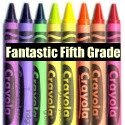This year is my 2nd year teaching writing. While I have been here for four years, the first two were spent teaching math to the 4th graders while the 4th grade teacher taught Language Arts to my 5th graders. We switched last year for a number of reasons, but because of the switch, last year’s writing curriculum was a bit scattered.
I knew what “paper” was coming next – personal narrative, how-to essay, formal letter, etc. – but didn’t really throw in much “instruction”, per se. I mean, we had several discussions on good introductions/conclusions, and at my school we use Four Square organizers so we spent the first few weeks refreshing the kids’ memories on how to use a Four Square. But there wasn’t much else. And I didn’t like that!
After much thought over the summer, I decided to implement teaching the 6 traits of writing. During the big back-to-school sale at TeachersPayTeachers, I purchased Down Under Teacher’s Six Traits VOICES Bulletin Board Headers and Cards. I created a bulletin board on the back of my bookcases after doing some rearranging (wish I had more wall space, but you gotta work with what you have!). I also purchased Ruth Culham’s 6+1 Traits of Writing to guide my teaching.
I started out the year by discussing the trait of Voice. I was going to start with Ideas but I had some great ideas for Voice that I really wanted to use to get the kids excited for writing!
To begin our discussion, we first talked briefly about each of the 6 writing traits and why we would be learning about them. We talked about how they can make us better writers if we are intentional about including them in our writing!
I love and have always loved the book The True Story of the Three Little Pigs by Jon Scieszka and couldn’t pass up the opportunity to use it! If you don’t know this story, it is a MUST read!! It tells the story of the three little pigs from the perspective of the wolf, who wants to make you think he is innocent. I shared this story with my class, asking them to pay attention to how the author made you feel about the wolf, the main character.
After reading, we talked about how the author was trying to portray the wolf; most of them agreed that he is seen as an innocent victim that we should feel sorry for. I described how this is the “voice” that the author chose to use in his book. He could have made the wolf continue to seem evil, or maybe made it a mysterious story, but he chose a voice of pity and innocence.
I then had the students choose a fairy tale that they could rewrite from the perspective of a “misrepresented” character. I reminded them to think about the voice they wanted to use – how did they want to portray their character? These were SO well done! I gave them about 30-45 minutes total over the course of a few days and allowed students to share when everyone had finished. Some of the fairy tales my students did included “Snow White”, writing from the queen’s perspective, “Hansel and Gretel”, writing from the witch’s perspective, and “Little Red Riding Hood”, writing from the wolf’s perspective. I was quite impressed with how well they did and hope to share some of them with you as soon as I collect their journals in which they are written!
The next activity we did I got from Ruth Culham’s book. I used Spotify to play for the students multiple versions of the song “Hey Jude” by the Beatles. I love this website because you can search for and play full versions of songs without having to pay for them or download them! I used versions by Elvis, Bing Crosby, Earl Scruggs, Ella Fitzgerald, and Frank Sinatra, as well as the original. As I played each version, the students wrote down thoughts about each one – images they got when listening, words that described the version, etc. After listening to all of the versions, we made a big list of everything the students came up with. They tended to enjoy the more upbeat, exciting versions rather than some of the ones that made you feel like you were going to fall asleep 🙂
I asked the students how listening to music can relate to writing. They realized that, even if I gave each student the same topic, no one would write the exact same thing – everyone’s work would “sound” different, just as each version of the same song was so different from the others! I think this is really what drove the point home.
We then made a master list on chart paper of all different voice descriptors (ideas can be found in Ruth Culham’s book) which I will leave posted in our room throughout the year.
As a last fun activity, I read the books Diary of a Worm and Diary of a Fly by Doreen Cronin. We thought about the voice the author used in each of these – silly, humorous, sarcastic at times – and then I gave the students an opportunity to choose an animal’s diary to write.
I am so excited to move on to all of the other traits. In fact, we started Ideas yesterday, but that will have to wait for another post! I really believe this will pay off in the students’ writing.
How do you teach the 6 traits? I’d love to hear more ideas!!
PS: You should most definitely go check out my friend Jenny’s blog! She and I went to Grove City together and now she is teaching 1st grade at my school. Her classroom is the CUTEST and I am so excited that she is joining the teacher blogging world! Yay Mrs. B!







































